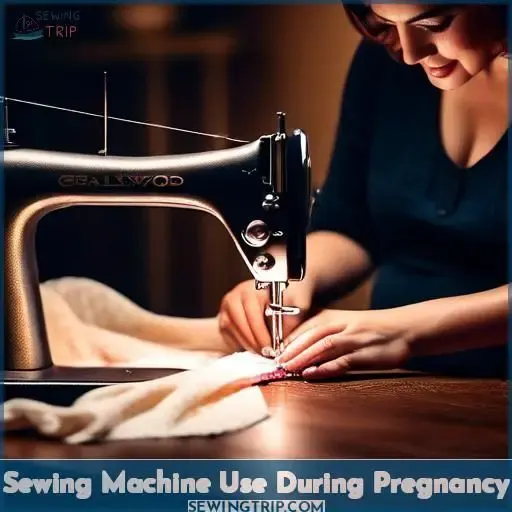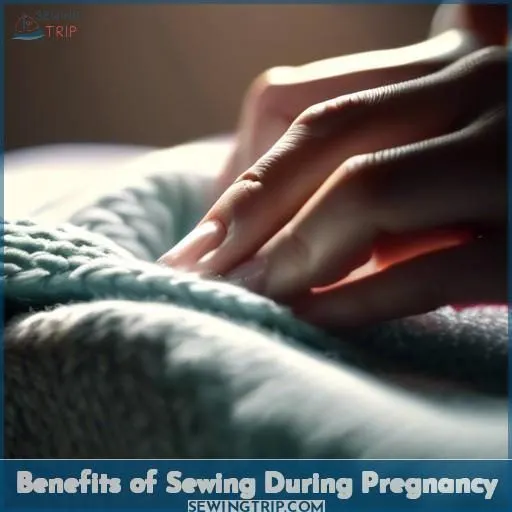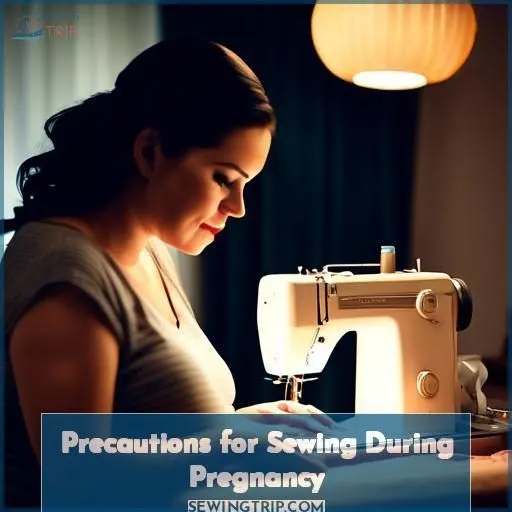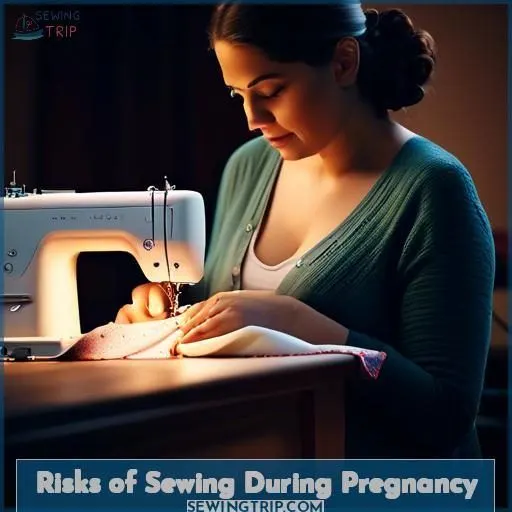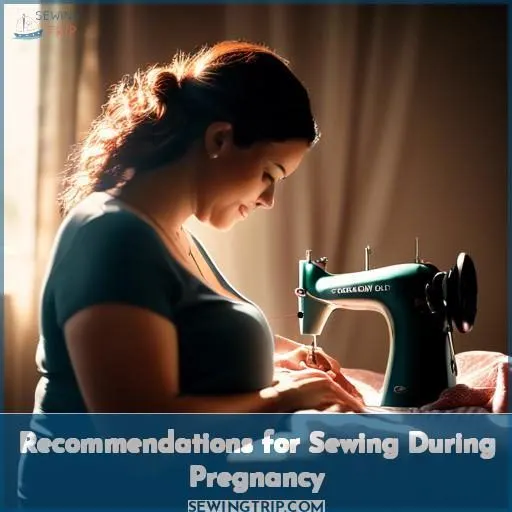This site is supported by our readers. We may earn a commission, at no cost to you, if you purchase through links.
You can safely use a manual sewing machine during pregnancy, but it’s best to consult your gynecologist first. Sewing provides relaxation and can even help create clothing for your baby.
However, take precautions like avoiding prolonged sitting, using proper lighting, and taking frequent breaks to stretch. While there are no known harms to the fetus, sewing does carry potential risks like eye strain and repetitive motion injuries if not done carefully.
To learn more about safely incorporating sewing into your pregnancy routine, we recommend consulting your healthcare provider.
Table Of Contents
Key Takeaways
- Sewing can be a safe activity during pregnancy, but it’s crucial to consult your healthcare provider before starting.
- Taking precautions such as avoiding prolonged sitting, using proper lighting, and taking frequent breaks can help minimize potential risks.
- Sewing can provide relaxation and stress relief, as well as a creative outlet for expectant mothers.
- Sewing during pregnancy can help create clothing for both the mother and the baby, providing a practical and cost-effective way to prepare for the arrival of a new family member.
Can Sewing Affect Pregnancy?
Sewing during pregnancy is generally considered safe. The vibrations of a sewing machine can’t harm the baby, who’s protected in the amniotic fluid and can’t feel the vibrations.
However, some experts recommend avoiding any severe exertion during the early stages of pregnancy, as it could potentially cause a miscarriage.
It’s also advised to be careful not to get hurt yourself while sewing, as pregnant women may be more clumsy.
Sewing Machine Use During Pregnancy
Are you considering using a sewing machine during your pregnancy? You’ll be glad to know that manual sewing machines are generally safe, but it’s always wise to consult your gynecologist before getting started. Just be mindful of avoiding prolonged sitting, changing positions frequently, and using cushions for support.
Can Use Manual Sewing Machine During Pregnancy
Yes, using a manual sewing machine is generally safe during pregnancy. However, it’s crucial to consult your gynecologist before starting to confirm its suitability for your specific situation.
While sewing, avoid prolonged sitting and change positions frequently to prevent back discomfort. Use cushions for added support and take breaks every 30-45 minutes to stretch and walk around.
Additionally, be mindful of proper posture and avoid lifting heavy objects or straining yourself.
Consult Gynecologist Before Use
Consulting a gynecologist before using a sewing machine during pregnancy is recommended for safety. Gynecologists can provide medical advice on any potential health concerns, such as pelvic pain or cervical incompetence, that may be exacerbated by sewing.
They can also discuss the use of foundation garments, like corsets, which can provide abdominal support and alleviate discomfort. Additionally, gynecologists can discuss the potential risks associated with sewing, such as the use of chemicals or heavy objects, and provide guidance on how to minimize these risks.
Avoid Prolonged Sitting
Sitting for prolonged periods can be detrimental during pregnancy, leading to discomfort, poor blood circulation, and increased risk of complications. To avoid these issues, pregnant women should change positions frequently and take breaks every 30-45 minutes.
Using a supportive chair with good back support can help maintain proper posture. A chair with a footrest can also help prevent swelling in the feet and ankles.
Using a standing desk or sitting at an angle of 90 degrees can help alleviate hip pain and improve blood flow. Regular stretching and walking can also help maintain proper blood circulation and reduce the risk of gestational diabetes and preeclampsia.
Change Position Frequently
After evading the dreaded chair marathon, it’s essential to stay active. Changing positions often can be your secret weapon against back, hip, and pelvic pain, making your sewing machine time more enjoyable.
- Stand and stretch every 30 minutes to keep those pains at bay.
- Alternate between sitting and standing if possible.
- Adjust your chair height regularly.
- Walk around your sewing space.
This interplay with your sewing machine not only keeps the aches away but also invigorates your creative hobby, ensuring you’re not just stitching together maternity wear but also cultivating a healthier pregnancy.
Use Cushions for Support
When sewing during pregnancy, providing proper back support is crucial to maintain comfort and avoid discomfort. Utilizing a comfortable chair with ample back support, such as an ergonomic chair, can greatly enhance your sewing experience.
Additionally, employing a seat cushion or pregnancy pillow can furnish extra lumbar support, which is particularly significant for pregnant women. These cushions can aid in mitigating pelvic and hip pain, as well as providing abdominal support, thereby reducing discomfort.
Benefits of Sewing During Pregnancy
Are you considering sewing during your pregnancy? You’ll be glad to know there are several benefits to picking up a needle and thread. Sewing can provide a relaxing creative outlet, help you pass the time, and even allow you to craft custom clothing for you and your little one.
No Known Harm
Using a sewing machine during pregnancy is generally considered safe, with no known harm to fetal development. It can be a relaxing method for expectant mothers, providing a creative hobby that offers comfort and support. Different styles of sewing machines and projects can cater to various preferences, enhancing the experience.
May Provide Relaxation and Stress Relief
Sewing can provide a calming and stress-relieving experience during pregnancy. Some women discover that sewing aids them in navigating the physical and emotional transformations that accompany pregnancy. Sewing also offers a creative outlet, enabling soon-to-be mothers to craft garments for themselves or their child. However, it’s imperative to prioritize safety and comfort** while sewing during pregnancy.
Firstly, avoid prolonged sitting and regularly change positions. This may alleviate discomfort and potential back pain. Utilizing cushions for support can also be advantageous. Furthermore, take breaks every 30-45 minutes to stretch and walk, which can assist in maintaining proper blood flow and preventing strain. Maintaining good posture is also vital to prevent any discomfort or possible injury.
Sewing can be a soothing activity, helping to reduce stress and anxiety during pregnancy. However, it’s important to pay attention to your body and take breaks as needed. Pregnancy can be a demanding and emotionally challenging time, so prioritizing rest and self-care is essential. Consulting with a healthcare provider or midwife can also provide tailored advice and guidance based on individual health needs and circumstances.
Can Create Clothing for Baby or Mother
Sewing during pregnancy can be a beneficial and enjoyable activity, providing several advantages both for the mother and the baby. One of the primary advantages is the ability to create clothing for the baby or mother. Sewing can be a practical way to make custom-tailored clothes that are comfortable and stylish. Here are some ways sewing can benefit you during pregnancy:
- Creating Clothing for Baby or Mother: Sewing allows you to create unique, personalized clothing items for your baby or yourself. This can be a great way to bond with your baby, as you can choose fabrics and styles that reflect your personal preferences and tastes.
- Cost-Effective: Sewing your own clothes can save you money compared to buying ready-made maternity or baby clothes. You can use high-quality fabrics and patterns to create items that will last longer and look better than store-bought options.
- Custom Fit: Sewing allows you to create clothes that fit perfectly, taking into account your changing body shape during pregnancy. This can be especially useful for maternity clothes, as it ensures a comfortable and flattering fit throughout your pregnancy.
- Empowerment: Sewing your own clothes can give you a sense of accomplishment and empowerment. It’s a skill that can be passed down to your children, creating a family tradition of handmade clothing.
Can Be a Creative Outlet
Sewing during pregnancy can be a creative outlet that offers stress relief, personal style, mental health benefits, and relaxation techniques. It allows you to express yourself through your work, which can be particularly valuable during this time.
A sewing machine can be a powerful tool for creating clothing for yourself or your baby, or simply for exploring your own artistic vision. By engaging in this activity, you can also pass the time in a productive and fulfilling way.
Can Help Pass Time
Sewing during pregnancy can be a beneficial activity for expectant mothers. It provides a creative outlet, helps reduce stress and anxiety, and can be a therapeutic way to pass the time. Here are some ways sewing can help pass the time during pregnancy:
- Mind and body relaxation: Pregnancy can be a stressful time, with hormonal changes and physical discomfort. Sewing requires concentration and focus, which can help take the mind off any worries or anxieties. The repetitive motions involved in sewing can also have a calming effect on the body, promoting relaxation and reducing stress levels.
- Creative outlet: Pregnancy can bring a flood of creative energy, and sewing provides an outlet for that creativity. From selecting fabrics and patterns to designing and creating unique items, sewing allows expectant mothers to express their individual style and create pieces for themselves or their baby. This creative outlet can boost mood and promote a sense of fulfillment.
- Connection with the baby: Sewing during pregnancy provides an opportunity for mothers to connect with their unborn baby. From sewing clothing and accessories for the baby to creating nursery decor, each stitch can be a reminder of the love and anticipation for the new arrival. This connection can deepen the bond between mother and baby, further enhancing the pregnancy experience.
- Practical and economical: Sewing during pregnancy can be practical and economical. Expectant mothers can sew their own maternity clothing, allowing for a perfect fit and customization. Sewing also gives the option to repurpose existing clothing or create new baby items, such as blankets, burp cloths, and bibs, which can save money compared to buying them from stores.
- Skill development: Sewing is a valuable skill that can be learned and improved upon during pregnancy. Learning to sew can be a rewarding experience and provide a sense of accomplishment. As skills progress, expectant mothers can take on more complex projects, further enhancing their sewing abilities and boosting self-confidence.
- Social engagement: Sewing during pregnancy can also be a social activity. Expectant mothers can join sewing groups or take sewing classes, allowing them to connect with other individuals who share their interest. These social interactions can provide a sense of belonging and create a support network, which can be particularly beneficial during pregnancy.
Precautions for Sewing During Pregnancy
When sewing during pregnancy, be careful not to strain or lift heavy objects. Additionally, use sharp objects like scissors with caution and take breaks to stretch and walk around. Maintaining proper posture is also essential, and if you have any concerns, be sure to consult your gynecologist.
Avoid Straining or Lifting Heavy Objects
When sewing during pregnancy, it’s essential to prevent straining or lifting heavy objects. Your body is already experiencing significant changes, and adding extra strain can lead to discomfort or injury.
Lifting heavy weights or objects can exert pressure on your back, pelvis, and abdomen, which can be harmful during pregnancy. Instead, use a comfortable chair with adequate back support, and take breaks every 30-45 minutes to stretch and move around.
Use Sharp Objects With Caution
When you’re sewing during pregnancy, it’s paramount to handle sharp objects with caution to safeguard both you and your baby. Here are some pointers on how to use sharp objects safely:
- Select the right tools: Invest in top-notch, ergonomic tools specifically designed for sewing. This will minimize the risk of mishaps and enhance your sewing experience.
- Use the appropriate tool for the task: Make sure you’re employing the correct tool for each job. For instance, use a bodkin instead of a safety pin when threading elastic through a waistband casing.
- Protect your hands: Use thimbles while hand sewing to shield your fingers from needle pricks.
- Store your tools securely: Keep your scissors, rotary cutters, and other sharp tools in a protective sheath or case when not in use.
Take Breaks to Stretch and Walk
Taking breaks to stretch and walk isn’t just about shaking off the cobwebs; it’s a game-changer for your health during pregnancy. Regular movement can ward off back pain and ease pelvic pressure, not to mention keeping gestational diabetes at bay.
Plus, a little stroll might just be the secret sauce to easing that pesky morning sickness. So, lace up and step out!
Maintain Proper Posture
Maintaining proper posture is vital during pregnancy to prevent discomfort, circulation issues, and potential back pain. Here are some tips to help you maintain good posture while sewing during pregnancy:
- Pelvic Tilt: Practice pelvic tilt exercises to strengthen your core muscles and alleviate lower back pain. Aim for a neutral alignment in the pelvis, which provides the most space in the pelvis and low back, relieving stress on the soft tissue and preventing muscle imbalances.
- Lower Back Pain: Avoid an increased curve in your low back, known as lordosis, which can cause pregnancy back pain. Instead, focus on tucking your chin, dropping your shoulders back and down, and reducing the curve in your low back.
- Lumbar Support: Use a chair with proper back support, such as an ergonomic office chair with high lumbar support. This can help maintain proper posture and reduce strain on your back.
- Back Alignment: Make sure your back is aligned correctly while sewing. Imagine there’s a string on the top of your head, pulling gently to keep your chin in a neutral position and your shoulders down and back. This will help maintain proper posture and reduce the risk of back pain.
Consult Gynecologist if Any Concerns
If you’re expecting and pondering about utilizing a sewing machine, it’s imperative to have a conversation with your OB-GYN prior to commencing. They can offer tailored counsel based on your pregnancy concerns and unique requirements. Keep in mind, safety measures are paramount when sewing during pregnancy, so don’t hesitate to seek healthcare professional advice.
Risks of Sewing During Pregnancy
Using a sewing machine during pregnancy is generally safe, though there are some potential risks to be aware of. As long as you take precautions and consult your gynecologist, sewing can be a relaxing and therapeutic activity during pregnancy.
While there are no known risks for manual sewing machines, you’ll want to avoid eye strain by using proper lighting and take breaks to prevent repetitive motion injuries.
None Known for Manual Sewing Machines
Using a manual sewing machine during pregnancy is generally safe, but it’s crucial to consult your gynecologist prior to use and adhere to certain safeguards. Refrain from extended sitting, modify positions often, and utilize cushions for support.
The rewards of sewing during pregnancy encompass relaxation, stress alleviation, crafting garments for baby or mother, a creative outlet, and time optimization. Nevertheless, there are certain precautions to bear in mind, such as avoiding exertion or lifting heavy objects, exercising caution when using sharp objects, taking intervals to stretch and ambulate, preserving appropriate posture, and consulting your gynecologist should any concerns arise.
Potential for Eye Strain if Not Using Proper Lighting
Don’t let eye strain ruin your sewing experience during pregnancy. Proper lighting is key to preventing eye fatigue, ocular damage, and visual disturbances. Invest in a well-lit workspace, or consider using a task lamp to illuminate your project.
Headaches are a sign that your eyes need a break. Take regular breaks to rest your eyes, and avoid prolonged exposure to bright lights. Your eyes will thank you.
Potential for Repetitive Motion Injuries if Not Taking Breaks
Just like avoiding eye strain requires proper lighting, dodging repetitive motion injuries hinges on not skimping on breaks. Here’s why:
- Rest is Best: Your muscles need a breather to prevent cramping and fatigue.
- Stretch to Fetch: Regular stretching keeps your joints happy and limber.
- Break to Make: Pausing actually boosts creativity and precision. Remember, a stitch in time saves nine!
Potential for Accidents if Not Using Machine Safely
Using a sewing machine during pregnancy can be safe if done with caution. Always use the machine safely during operation, ensuring you’re well-versed in its use and aware of potential hazards. Take breaks to stretch and walk, and maintain proper posture to avoid discomfort or injury. Consult your gynecologist if you have any concerns.
Recommendations for Sewing During Pregnancy
When sewing during pregnancy, make sure to use a comfortable chair with good back support to avoid discomfort. Additionally, be mindful of proper lighting to prevent eye strain, and try not to sew for extended periods to minimize fatigue.
Use a Comfortable Chair With Good Back Support
To guarantee comfort and avert back pain, leg cramps, and pelvic tilt while sewing during pregnancy, employ a chair with sound back support and a footrest. Modify the chair’s lumbar support to sustain proper posture and alleviate strain on your lower back. Taking breaks to stretch and alter positions can also assist in reducing discomfort.
Use Proper Lighting to Avoid Eye Strain
Adequate lighting is essential when sewing during pregnancy to prevent eye fatigue. Consider investing in a well-illuminated sewing space or utilizing an adjustable light source to modify the intensity and orientation.
Take periodic breaks to give your eyes a respite and consider wearing blue light-filtering glasses if you’re interacting with electronic devices.
Eye well-being is paramount, so ensure you prioritize eye care throughout your sewing endeavors.
Avoid Sewing for Extended Periods of Time
To avoid foot pain and back discomfort while sewing during pregnancy, it’s important to take breaks every 30-45 minutes. This gives your feet a chance to rest and your back a chance to stretch.
Additionally, using a comfortable chair with good back support can help relieve lower back pain.
Frequently Asked Questions (FAQs)
Can sewing improve hand-eye coordination during pregnancy?
Sewing can enhance your hand-eye coordination during pregnancy. The repetitive motions and focus required hone your fine motor skills, which can benefit both you and your growing baby. Get sewing – it’s a win-win!
Are there specific sewing patterns recommended for pregnant women?
Regarding sewing patterns for expecting mothers, comfort and flexibility are paramount. Opt for relaxed, flowing designs that adapt to your evolving physique. Give precedence to patterns that empower you to move unrestrained and experience tranquility.
How does sewing impact emotional well-being in pregnancy?
Sewing can be a soothing, creative outlet during pregnancy, helping you manage stress and feel empowered. The rhythmic motion and productive focus may boost your mood and emotional well-being throughout this transformative time.
Can sewing contribute to developing a maternal bond?
Sewing during pregnancy can be a powerful way to nurture the maternal bond. It allows you to create tangible mementos that symbolize your growing connection with your baby. The creative process can also foster a sense of calm and emotional fulfillment.
Are there community sewing groups for pregnant individuals?
You’ll be glad to know 1 in 4 expectant parents join sewing groups. These welcoming communities offer a creative outlet, peer support, and the chance to make cozy nursery items. Why not check out one near you?
Conclusion
Ultimately, sewing during pregnancy can be a safe and enjoyable activity if you take the proper precautions. By consulting your healthcare provider, using a manual sewing machine with care, and incorporating breaks and proper ergonomics, you can safely incorporate sewing into your pregnancy routine.
The answer is that sewing can affect pregnancy, but with the right approach, sewing can be a relaxing and rewarding experience throughout your pregnancy.


